Rare
Books
Coronelli
Globe

Coronelli
Globe and Rotunda. Image courtesy
Helmut Guenschel, Inc.
![]() ocated
in the Coronelli Rotunda within the Southwest Collection/Special Collections
Library
http://swco.ttu.edu/
stands one of Texas Tech University's treasures:
Coronelli's 1688 Terrestrial Globe. One of only three in North America,
the globe was designed and constructed in the Venetian workshop of the
Franciscan Father
Vincenzo Coronelli. It is likely that the 1.07 meter (3.5 ft.) globe was
paired with a
celestial
counterpart illustrating the night sky, but its whereabouts are currently
unknown. In addition,
Texas Tech's globe most likely had a
stand similar to the one in
this engraving.
ocated
in the Coronelli Rotunda within the Southwest Collection/Special Collections
Library
http://swco.ttu.edu/
stands one of Texas Tech University's treasures:
Coronelli's 1688 Terrestrial Globe. One of only three in North America,
the globe was designed and constructed in the Venetian workshop of the
Franciscan Father
Vincenzo Coronelli. It is likely that the 1.07 meter (3.5 ft.) globe was
paired with a
celestial
counterpart illustrating the night sky, but its whereabouts are currently
unknown. In addition,
Texas Tech's globe most likely had a
stand similar to the one in
this engraving.
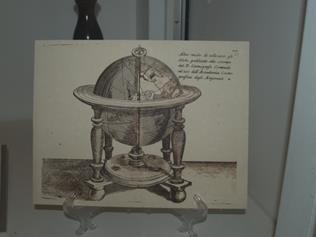
Both the celestial and terrestrial globes were based on the two 3.84 meter (12.5
ft.) diameter globes
Coronelli presented to King Louis XIV in 1683. Shrewdly capitalizing on his
connection to the French throne, Coronelli was able to secure additional
financial and political backing from the Roman Catholic Church and the Venetian
government. This support enabled
Coronelli to establish his workshop and to aggressively elicit geographical and
astronomical information from some of Europe's leading scientists and explorers.
The result was not only the creation of the largest printed globes of its time,
but a whole series of maps, atlases, star charts and even the first
alphabetically-arranged dictionary.
Coronelli's 1688 globe illustrates the extent of late 17th century
European exploration. For example, the Eastern shore line of Australia, here
named "New Holland", is not drawn in.
In fact, it would be almost 90 years until
James Cook
would survey and map the region.
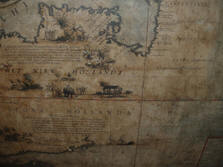
Much closer to the globe's present home, the Mississippi River is located far to
the west of its actual route, although the French explorer Robert de La Salle
had navigated down the Mississippi in 1682.
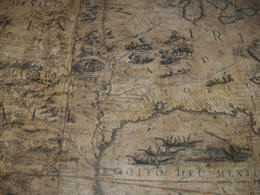 .
.
The Recent History of Texas Tech University's Coronelli Globe
Little is known of Texas Tech's Coronelli Globe from the time of its construction in 1688 until 1930. It was then that the American newspaper magnate and tireless art collector William Randolph Hearst purchased it for $3,250 from Arnold Seligmann, a Paris antiques dealer. Seligmann probably mated the globe with its present base, which, although approximately the same age as the globe, may originally have supported a flag pole.
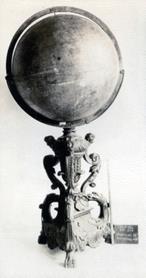
Photo of globe from Hearst's album documenting his art and antiquities
collection.
Hearst never uncrated the globe, storing it instead in one of his massive
warehouses until it was sold at his historic auction in 1941.
The globe's scant catalog description, squeezed between everything from
suits of armor to complete medieval rooms, incorrectly dated it as being from
the 1500's. The purchaser was Texas
businessman Harry E. Stewart, whose winning bid of $750 was less than a quarter
of what Hearst had originally paid.
In 1963 the Dallas oilman Robert B. Moody purchased the globe from Stewart's
estate.
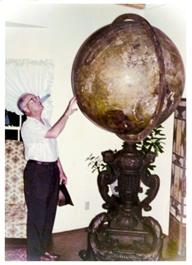
In 1968 the Texas Tech Friends of the Library bought the globe from Moody for
$7,500 as the Library's one millionth acquisition.
The globe's meridian arrived at Tech in several pieces, and had to be
reconstructed and strengthened with a brass hoop.
Displayed until 1984 in the Library's foyer, the globe was removed from
public display due to its deteriorating condition.
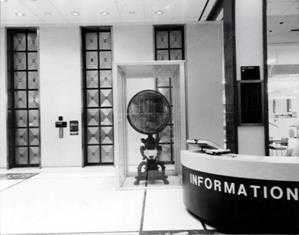
Realizing the globe's historic and aesthetic significance, Texas Tech Regent
James E. Sowell provided funding for an extensive conservation treatment, which
was undertaken by Doug Stone of Fulkerstone Fine Arts Conservation located in
Milwaukee, Wisconsin.
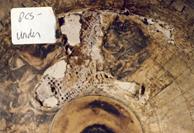
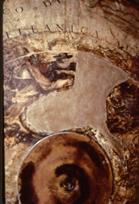
Damaged southern polar region The same region after repair
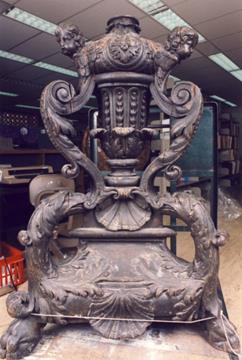
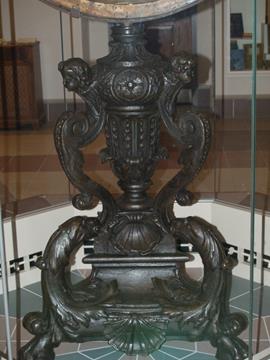
The base pre repair The base now
In May of 1997, the globe was rededicated in honor of Texas' First Lady, Laura
Bush, shown below with Dr. E. Dale Cluff, Dean of Libraries of Texas Tech
University.
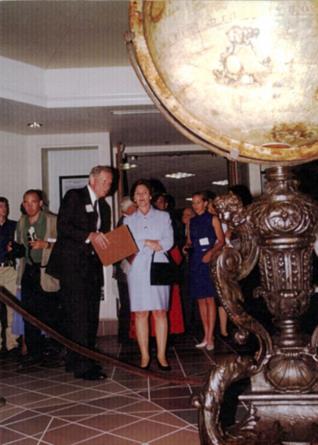
On Ms. Bush's left in the photo below is James E. Sowell.
To her right is Grover E. Murray, President of Texas Tech at the time of
the globe's original acquisition.

In order to provide a secure environment for the Coronelli globe, a custom
exhibit case was constructed by
Helmut Guenschel.
Positioned in the center of a rotunda built especially for the globe, the
case features optical grade glass with seamless joints and fiber optic lighting.
Around its base is a step, designed both to facilitate viewing of the
globe and to contain trays of silica gel that stabilize the enclosure's relative
humidity.
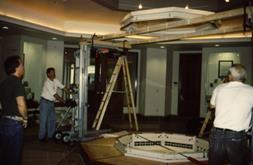
Helmut Guenschel installing the exhibit case.
For
additional information, please contact:
Rob E. King
rob.e.king@ttu.edu
(806) 834-0397
